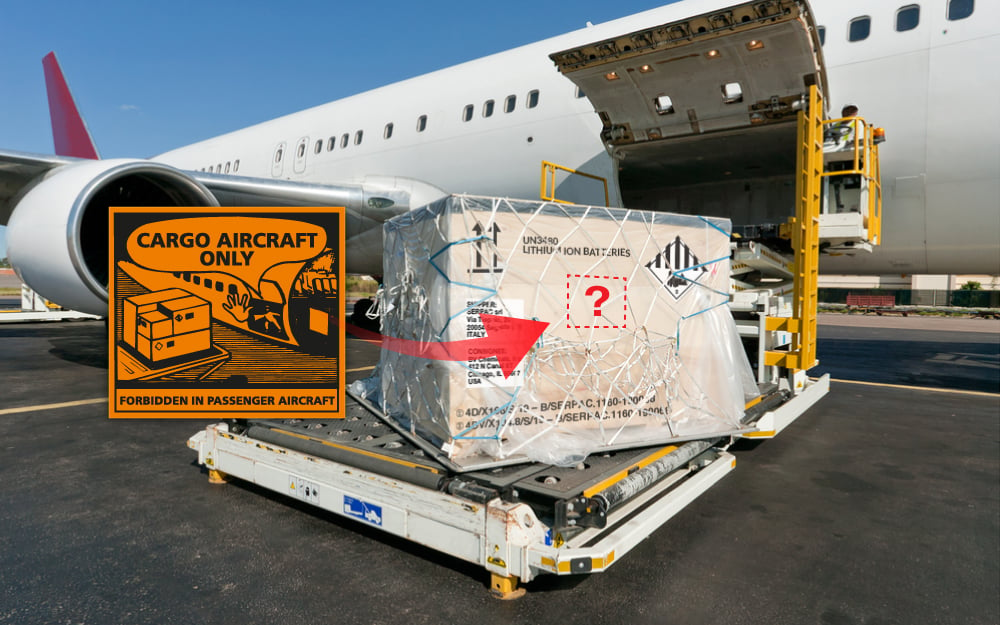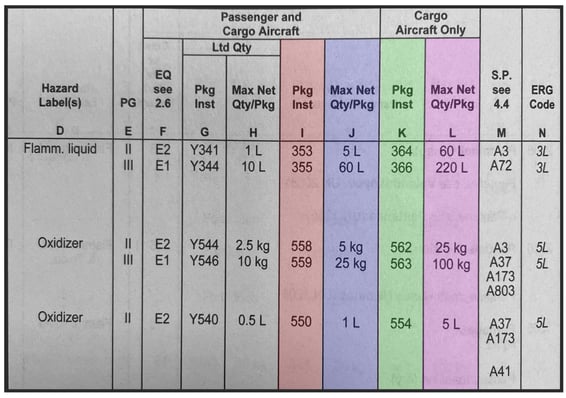CARGO AIRCRAFT ONLY (CAO): A GUIDE TO COMPLIANT LABELLING

If you ship dangerous goods by air ICAO-TI / IATA, you might have already noticed the “CAO” (Cargo Aircraft Only) label among the most used labels on purpose for this transport modality.
In chapter 7.2.4.2. IATA, regulations specify that:
“The Cargo Aircraft Only label (see Figure 7.4.B) must be used on packages containing dangerous goods that are permitted only on cargo aircraft. However, where the packing instruction number and the permitted quantity per package are identical for passenger and cargo aircraft, the Cargo Aircraft Only label should not be used. The Cargo Aircraft Only label must not be used for packages packed according to Passenger Aircraft limitations (Subsection 4.2, Columns G and H and/or I and J) even when included on a Shipper's Declaration marked Cargo Aircraft Only because of other packages in the shipment.”
“Cargo Aircraft Only” label means, as the name states, that a certain package containing dangerous goods is banned from going onto a passenger aircraft but can be loaded and transported only on a cargo aircraft, thus aircrafts meant exclusively for goods transports.
This is not a personal choice or the most convenient one, but this solution is adopted according to some specific “details” and restrictions that are enforced by regulations on transportation by air.
CAO label has a clearly recognizable design, is in black and orange and, with just a few exceptions, has a minimum size of 120*110 mm.
What are the most useful instructions to ship in compliance?
People involved in packaging to be shipped by air IATA must be trained properly and must be able to package complying with the existing regulations.
Among the basic expertise, it is required that the operator can interpret and read the specifications contained in the IATA DGR, especially the list of dangerous goods in chapter 4.2.
In the case of fully regulated shipments, the key figures are:
- Column I: packing instructions for shipments on both passenger and cargo aircraft.
- Column J: max net weight per package per shipment on both passenger and cargo aircraft.
- Column K: packing instructions for shipments on cargo aircraft only.
- Columna L: max net weight per package per shipment on cargo aircraft only.
Here below you can find an example of these columns from the 62nd edition of IATA regulations:

Three main occasions when you need a CAO label
Let us see now the three main occasions of use for a CAO label
1) Bigger quantities than the ones allowed on a passenger aircraft (columns I and J).
Here we can distinguish two different situations that will oblige you to ship on a cargo aircraft
-
- The net quantity of the package you have prepared, or you are about to prepare exceeds the limits set in column J:
In this case, it is easy to understand that it is not possible to ship on a passenger aircraft. It is then necessary to respect the packing instruction of column K and ship on a cargo aircraft (unless you do not decide to reduce the quantities). - Net quantity of the inner packaging that you have prepared, or you are about to prepare exceeds the limits defined in the PI written in column I:
When you check the PI, you must pay attention to the quantities you have loaded in every inner packaging. If they are bigger than the ones allowed on a passenger aircraft, you must verify if you can ship on a cargo aircraft (unless you do not decide to reduce the quantities).
- The net quantity of the package you have prepared, or you are about to prepare exceeds the limits set in column J:
2) Same PI, but different maximum net quantities per package between passenger aircraft (columns I and J) and cargo aircraft (columns K and L).
For some UN numbers only, it might happen that the PI on columns I and K will be the same and that there is a difference only for what concerns maximum net quantities per package, thus in columns J and L.
For instance, UN1968 Insecticide gas, n.o.s., follow the same PI 200 both for passenger and cargo aircraft, but maximum allowed weights change.
In this case, if the net quantity of the package is bigger than the one indicated in column J, transport will be done as “Cargo Aircraft Only,” thus the use of CAO labels will be compulsory.
3) "Forbidden" for Passenger and Cargo Aircraft.
Another situation happens when columns I and J (passenger and cargo aircraft) contain the word “Forbidden” for the UN number corresponding to the goods that you want to ship, and only shipment on cargo aircraft is allowed. Here, also, CAO label use is compulsory.
4 SITUATIONS WHERE CAO LABEL IS FORBIDDEN
Let us see now the four situations when the use of CAO labels on packages containing dangerous goods is forbidden:
1) Shipment of more packages on a passenger and cargo aircraft.
If one or more packages are compliant to be transported on a passenger aircraft and have been prepared following the quantity limits as per columns G and H (LQ transport) and columns I and J (fully regulated transport by passenger and cargo aircraft), and if these packages are part of a shipment containing CAO packages, these packages (LQ or fully regulated by passenger and cargo aircraft) must not have CAO label.
2) Same PIs and same maximum net quantities per package between passenger aircraft (columns I and J) and cargo aircraft (columns K and L).
A package containing goods with a UN number that in the list of dangerous goods (chapter 4.2) has the same PI and the same maximum net quantity allowed both on passenger aircraft and cargo aircraft must not carry a CAO label.
3) Same PIs but no quantity limit
When and if, in the list of dangerous goods of IATA regulation, a UN number both for passenger aircraft and for cargo aircraft have the same PI (columns I and K) and “no limit” indication in columns J and L (maximum net quantity allowed per package), the use of CAO labels is prohibited.
4) Package compliant to passenger aircraft shipment
If a package is prepared according to the related PI (column I), if it respects the limits of the maximum net quantities per package (column J) and it is suitable to be transported on passenger aircraft, CAO labels must not be applied.
As we have seen before, labelling, and marking of packages shipped on a cargo aircraft follow well-defined rules and dispositions as we have seen in all other situations.
CAO labels must therefore be put or not put according to the specific case and must not be used according to one’s instinct or a personal choice of the preferred transport or shipment mode.
It is good to remember that, for compliant transport by air, you must comply with all directions of DGR IATA, not only the ones about labelling and marking. For instance, the ones about UN-certified packaging, when requested, or the possible filling of the Shipper’s Declaration.
-1.jpg?width=300&name=Aricraft-Cargo-Only-(CAO)-1.jpg)